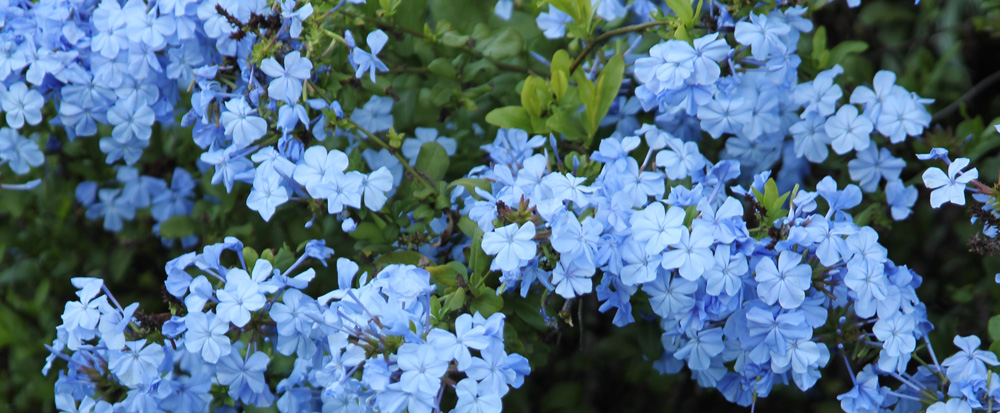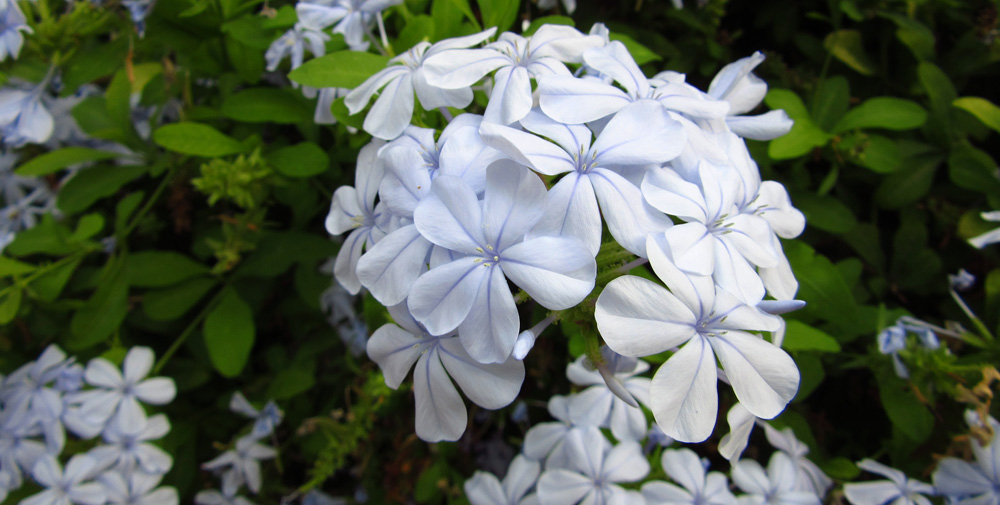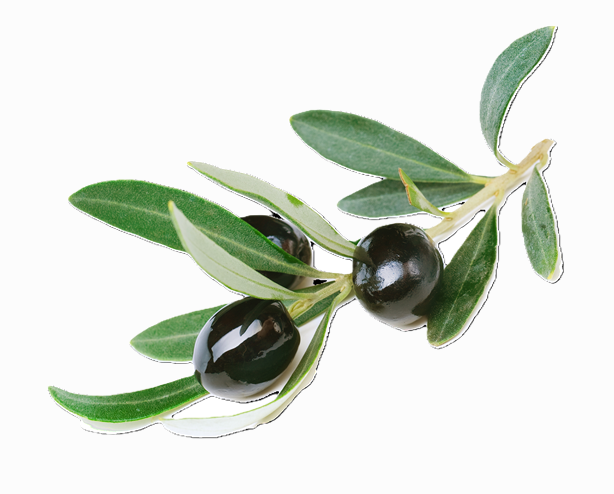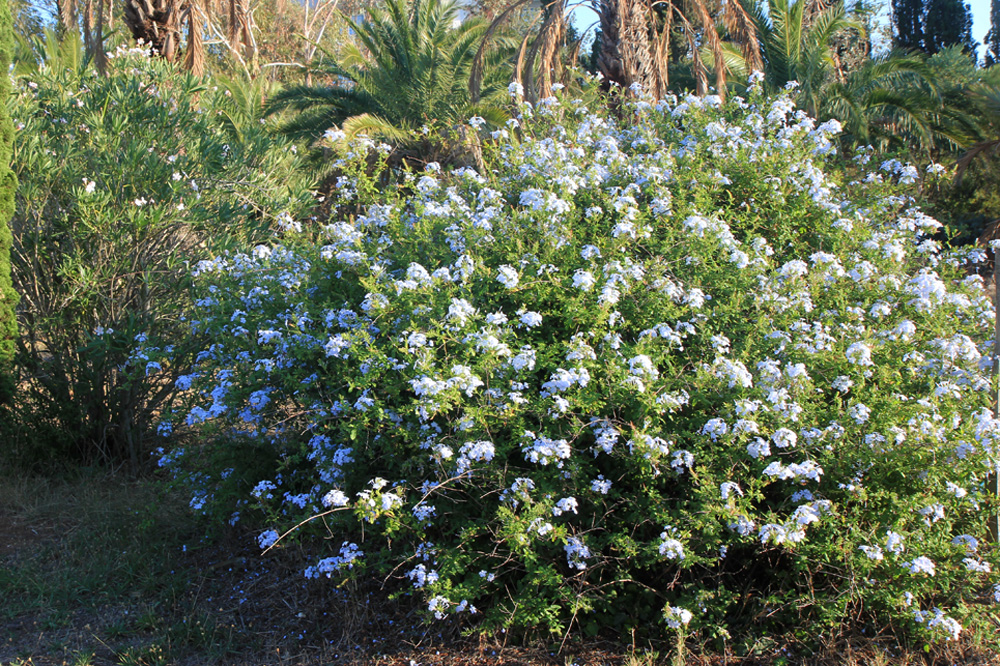Plumbago auriculata

A very deserving plant that I recommend for the Mediterranean south is Plumbago auriculata syn. P. capensis (Cape plumbago). It is of South African origin and is suitable for the fairly mild south (USDA zones 8B, 9 and milder zones). I particularly like the cultivar with dark blue flowers, for the following reasons:
Une plante très méritante que je recommande pour le midi méditerranéen, est Plumbago auriculata syn. P. capensis, le Plumbago du Cap. D’origine sud-africaine, il convient aux jardiniers du midi assez doux (zones USDA 8B, 9 et zones plus douces) et je recommande particulièrement le cultivar à fleurs bleu foncé, pour les raisons suivantes :
- Easy to obtain.
- Abundant, long-lasting flowering (from the end of April to the end of October here).
- Unusual colour for gardens in the south of France, a beautiful cobalt blue, very fresh-looking in summer, in regions where hydrangeas cannot be grown.
- Very well adapted to most soils, even chalky ones, provided they are not too compact or shallow (improve the soil around the root ball).
- Great resistance to drought (even intense and prolonged drought such as in 2022 and the summer of 2023 in Roussillon, for plants that have been established for more than two years). My plumbagos grew and flowered without any watering.
- The plant is resistant to strong sunlight – it needs sunshine. Plant in full sun with space around it.
- Very vigourous: To be avoided in a small garden.
- Easy to cut or divide. Sometimes self-seeds.
- Facile à se procurer
- Floraison abondante de longue durée (de fin avril à fin octobre ici).
- Fleurs d’une couleur inhabituelle dans les jardins du midi, un beau bleu de cobalt, très rafraichissant en été dans des régions où on ne peut pas cultiver d’hydrangeas.
- Très bonne adaptation à la plupart des sols même calcaires, à condition de ne pas être trop compacts ou superficiels (améliorer le sol autour de la motte).
- Grande résistance à la sécheresse (même intense et prolongée des plantes établies depuis plus de deux ans comme l’année 2022 puis l’été 2023 dans le Roussillon). Mes Plumbagos ont poussé et fleuri sans aucun arrosage.
- La plante résiste à une forte insolation et la demande. Planter en plein soleil dans un endroit spacieux.
- Grande vigueur : à éviter dans un petit jardin,
- Bouturage ou division de touffe facile. Se sème parfois.
One small problem is that the flowers tend to stick to clothes or the soles of shoes: do not plant it near a passageway (see the Plantzafrica article on the use of flowers as earrings).
Petite difficulté, les fleurs ont tendance à coller aux habits ou semelles de chaussures : ne pas placer près d’un passage (voir dans l’article Plantzafrica l’utilisation en boucles d’oreilles des fleurs).
The Achilles’ heel of this plant is its low resistance to frost. Temperatures of -2°C damage the tips, -5°C to -7°C is enough to kill many branches but not the plant, intense cold of around -10°C can kill the plant, (its cultivation has long been reserved for the orange tree zone). The dark blue flowered cultivar, in addition to its highly decorative flowers, is slightly more resistant to cold than plants with pale blue or white flowers.
Le tendon d’Achille de cette plante est une assez faible résistance au gel : des gels de -2°C abiment les extrémités, -5°C à -7°C suffisent à tuer beaucoup de branches mais pas la plante, des froids intenses de l’ordre de -10°C peuvent tuer la plante (sa culture a longtemps été réservée à la zone de l’oranger). Le cultivar à fleurs bleu foncé, outre ses fleurs très décoratives, est un peu plus résistant au froid que les plantes à fleurs bleu pâle ou blanches.
Where such frosts are infrequent, it is still possible to grow plumbago thanks to:
- the fact that flowering occurs on branches that develop in spring (a winter frost will not prevent flowering the following summer).
- the great vigour of well-established plants with numerous underground branches
Si ces gels sont rares, la culture du plumbago est tout de même possible grâce à :
- le fait que la floraison survienne sur les rameaux qui se développent au printemps (un gel hivernal ne privera pas d’une floraison l’été suivant).
- la grande vigueur des plantes bien établies qui ont de nombreux rameaux souterrains
In slightly colder regions, such as the hinterland of Languedoc and Provence, you can surprise your neighbours by adapting the cultivation of this plant. Once the cold weather is over, plant it in a sheltered, very sunny spot. Take care when planting and water regularly during the first summer. Prune all the stems to around 15 cm from the ground from mid-November onwards, or as soon as the first light frost occurs, and mulch to a depth of 15 to 20 cm. In spring, pull back the mulch to the edges of the clump and water at least once as soon as young shoots are visible.
Dans les régions un peu froides, comme l’arrière-pays du Languedoc et de Provence, vous pouvez étonner vos voisins en adaptant la culture de cette plante. La placer dès le printemps après les gels, dans un endroit abrité et très ensoleillé, soigner sa plantation et arroser régulièrement le premier été, tailler bas (vers 15 cm de hauteur) toutes les tiges dès la mi-novembre, ou sitôt après le premier gel léger, et pailler ou mettre du mulch sur 15 à 20 cm. Au printemps écarter en périphérie de la touffe la paille ou le mulch et arroser au moins une fois dès que de jeunes pousses sont visibles.
A little nomenclature and explanation of the commercial and vernacular names
The currently valid name for this plant is Plumbago auriculata because of a peculiarity of the leaves. The later name, Plumbago capensis, is a synonym, but is a useful reminder of the plant’s South African origin. In France, it is commonly known as ‘dentelaire du Cap’ because its European cousin, Plumbago europaea, has a root with antiseptic properties, used to soothe toothache. The name of the genus, plumbago, derives from the Latin word ‘plumbum’ meaning ‘lead’ and may refer to its lead-blue flower colour, or to Pliny’s belief that the plant was a cure for lead poisoning. The species has pale blue flowers, but there is also a form with white flowers Plumbago auriculata f. alba(not very vigorous and very sensitive to frost) and a cultivar with dark blue flowers called ‘Royal Cape’ in South Africa, but ‘Dark Blue’ in France.
Un peu de nomenclature et d’explication des noms commerciaux et vernaculaires.
La dénomination actuelle valable de cette plante est Plumbago auriculata à cause d’une particularité des feuilles, le nom Plumbago capensis donné plus tard n’en n’est que synonyme mais est bien pratique pour se rappeler l’origine sud-africaine de cette plante. On l’appelle communément dentelaire du Cap, car son cousin européen, Plumbago europaea était appelé dentelaire du fait que sa racine qui a des propriétés antiseptiques, était utilisée pour calmer les douleurs dentaires. Le nom du genre, plumbago, dérive du mot latin « plumbum » qui signifie « plomb » et peut faire référence à la couleur bleue de la fleur ou à la croyance de Pline, selon laquelle la plante était un remède contre le saturnisme. La plante « sauvage » a des fleurs de couleur bleu pâle ; les horticulteurs ont sélectionné une forme à fleurs blanches Plumbago auriculata f. alba (peu vigoureuse et très sensible au gel) et un cultivar à fleurs bleu foncé appelé ‘Royal Cape’ en Afrique du Sud, mais ‘Dark Blue’ en France.

Bibliography
Plantes du Midi, P. Cuche, Edisud 1999, ISBN 2-7449-0546-1
On the Internet, for English speakers, the excellent South African article in ‘Plantzafrica’:
https://pza.sanbi.org/plumbago-auriculata
Texte et photos: Pierre Bianchi
![]()


